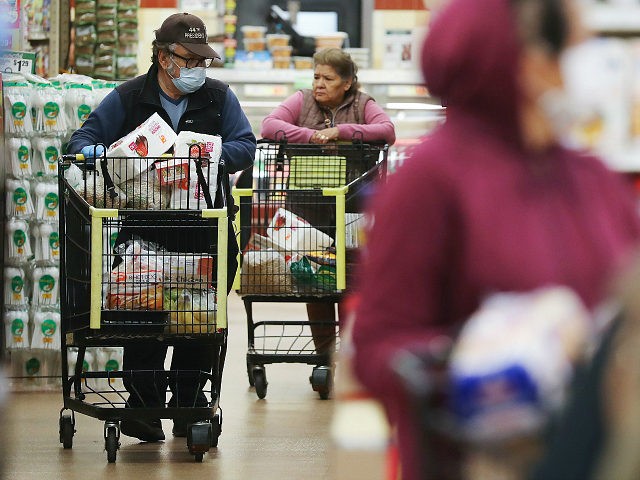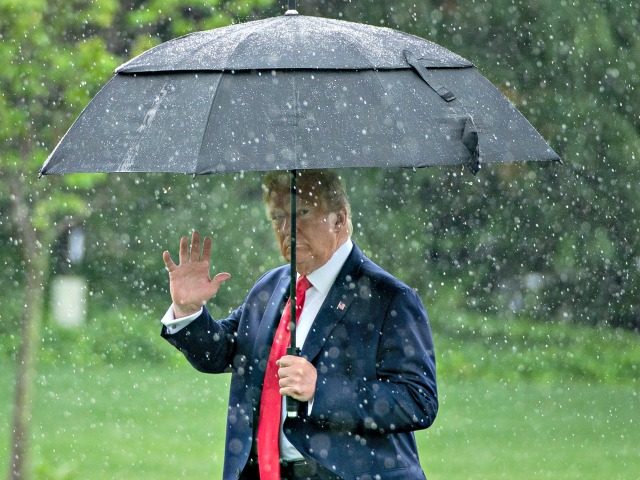Food Stamp Usage Climbs by 5.9 Million Since Coronavirus Pandemic Began

An additional 5.9 million people in the United States are on food stamps since the coronavirus pandemic began in March 2020, according to the latest data from the U.S. Department of Agriculture (USDA).
The USDA data showed that in March 2020, the month the pandemic hit the U.S., 37,140,169 individuals were receiving food stamps. Yet in April, that number soared by an estimated 5.9 million to 42,995,224 individuals.
Before the huge spike in enrollment due to the coronavirus, food stamp enrollment had been on a steady downward trend since the beginning of President Donald Trump’s first full month in office — February 2017 — to February 2020, the month before the coronavirus pandemic fully hit the U.S.
The coronavirus pandemic caused people to lose their jobs, causing financial instability and a need for them to go on food stamps to survive.
The government responded by enacting the Families First Coronavirus Response Act to provide temporary assistance to those in need of food and suspending the work requirement for those ages 18 to 49 without children or dependents.
The Act also allowed states to provide emergency Supplemental Nutrition Assistance Program (SNAP) benefits and to provide an additional allotment to all households up to the maximum amount for their household size.
The act also allowed meal replacement benefits through SNAP for households with children who attend a closed school and would have otherwise received a free or reduced-price meal while at school.
The administrative flexibility has caused a huge boost in SNAP participation, although the USDA has suggested it may start limiting some of these key flexibilities by September.
As of August 6, 16 states and the District of Columbia are eligible for USDA-approved SNAP waivers.
U.S. Producer Prices Jump Higher Than Expected in July

The U.S. producer price index rose up an unexpected 0.6 percent in July, biggest gain since October 2018, boosted by a sharp rise in energy prices.
Despite the rise, inflationary pressures remain extremely low. Compared with a year ago, the producer price index was 0.4 percent lower, according to data released by the Labor Department Tuesday. Prior to the pandemic, the index indicated prices were rising at around a 2 percent annual rate.
In June, the producer price index fell a seasonally adjusted 0.2 percent.
The Labor Department’s producer price index is an inflation metric. While the more familiar consumer price index measures inflationary pressure by looking at prices paid by consumers, the producer price index measures what businesses receive for goods and services.
The index for final demand goods — those sold to consumers and businesses at the end of the production chain —rose 0.8 percent in July, the third consecutive move higher. Over one-third of the July increase was due a rise in the price of gasoline, which jumped 10.1 percent. In contrast, prices for
final demand foods declined 0.5 percent.
The index for final demand goods less foods and energy moved up 0.3 percent.
The gauge of prices for transportation and warehousing dropped 0.8 percent.
The index for final demand services jumped 0.5 percent in July. About 60 percent of the rise can be traced to a 0.4-percent increase in prices for final demand services less trade, transportation, and warehousing. Margins for final demand trade services, which measures changes in margins received by businesses, also moved higher, advancing 0.8 percent.
The Labor Department said that a 7.8-percent jump in the index for portfolio management was a major factor in the advance in prices for final demand services.
The indexes for machinery and vehicle wholesaling, automobiles and automobile parts retailing, machinery and equipment parts and supplies wholesaling also moved higher. On the other hand, airline prices dropped 7.0 percent.
Materials for construction rose 1.3 percent, reflecting the ongoing housing market boom as many Americans seek out suburban homes to escape city life and the confines of urban apartments.
Small Business Optimism Tumbles as Virus Uncertainty Climbs

The confidence of small business owners in the U.S. took a hit in July as coronavirus case surged and reopening plans were delayed or rolled-back, data from the National Federation of Independent Business showed Tuesday.
The NFIB’s Small Business Optimism Index fell 1.8 points to 98.8 in July. Economists had expected the index to hold its June level of 100.
“This summer has been challenging for many small business owners who are working hard to keep their doors open and remain in business,” NFIB’s chief economist Bill Dunkelberg said.
The index has generally been riding high during President Donald Trump’s first term but tumbled nearly 20 points in March and April, the biggest ever drop in the index. That slide stopped in May and the index climbed higher in June as the economy began to reopen.
Reports of expected better business conditions in the next six months declined 14 points to a net 25 percent, a steep decline that indicates businesses realizing that the reopening will take longer and be less smooth as the virus continues to plague the U.S. economy.
The index is compiled from a survey that is conducted each month of NFIB members. July saw increases in four of the 10 index components compared with June. Five components declined and one was unchanged.
Plans to increase employment improved for the month, with a net 18 percent of businesses saying they would be hiring in the next three months. That’s up 2 points from June and 17 points above the April low.
Nearly half, 49 percent, of owners reported capital spending in the last six months, up one point from June but 14 points below the January level. Twenty-six percent of owners are planning capital outlays in the next few months, a rise from June but still low enough to be a “recessionary levels,” according to the NFIB.
“Currently, the outlook for sales growth is not strong and uncertainty levels are high, both deterrents to making investments for the future,” the NFIB said in its report.
A net negative 28 percent of all owners reported higher nominal sales in the past three months, up 3 points from June but still what the NFIB calls “a terrible number.”
“Even with states re-opening, sales are often lower due to business restrictions, social distancing requirements, and a still-reduced willingness of consumers to go out and mingle with the general population,” the NFIB said.
Sales expectations in the next 3 months fell 8 points to a net 5 percent.
“Closing stores and sheltering-in-place resulted in a 13 percent decline in consumer spending in April. Then, whipsaw, spending rose 16 percent in May,” the NFIB said. “Lower income consumers increased their spending to near pre-Covidlevels, but higher income consumers are holding back.”
The NFIB Uncertainty Index increased 7 points to 88.
No comments:
Post a Comment